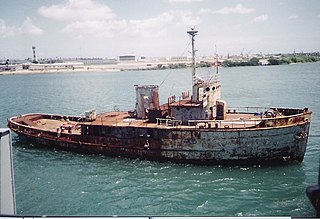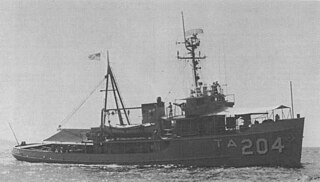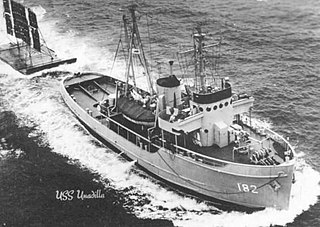
USS Salish (ATA-187) was a Sotoyomo-class rescue tug of the US Navy. Her hull was laid down on 29 August 1944. She left US service on 10 February 1972 and was recommissioned in the Argentine Navy on the same day as the ARA Alférez Sobral (A-9).
USS Navajo (ATR-138/ATA-211) was an auxiliary ocean tug in the United States Navy.
USS Keosanqua (ATA-198) was a Maricopa-class auxiliary fleet tug of the United States Navy. The ship was authorized as Rescue Ocean Tug ATR-125, and redesignated Auxiliary Fleet Tug USS ATA-198 on 15 May 1944. The ship was laid down at Levingston Shipbuilding Co., Orange, Texas, launched on 17 January 1945, and commissioned on 19 March 1945, Lieutenant J. L. Bean in command. She was named Keosanqua (ATA-198) on 16 July 1948.

USS Tunica (ATA-178) was a Sotoyomo-class auxiliary fleet tug acquired by the United States Navy for service during and after World War II.
USS ATA-176 was an ATR-1-class rescue tug built for the United States Navy during World War II. She was laid down on 30 January 1944 and launched on 1 March as USS ATR-103, but was re-designated ATA-176 on 15 May. She was commissioned as USS ATA-176 on 19 August. She served in the U.S. Pacific Fleet during the war and was decommissioned on 30 June 1947. She was then manned with a civilian crew and placed in service, being renamed USNS Tonkawa (T-ATA-176) on 16 July 1948. Tonkawa, the first U.S. Navy vessel named for the Tonkawa, was taken out of service in 1956 and placed in reserve.
USS Wateree (ATA-174), the third ship named USS Wateree, was a Sotoyomo-class auxiliary fleet tug in the service of the United States Navy during World War II. She later served with the Military Sea Transportation Service and the Peruvian Navy as a diving support ship. In Peruvian naval service she was renamed BAP Unanue (ATA-136).
USS Penobscot (ATA-188/ATR–115) -- a Sotoyomo-class auxiliary fleet tug—was originally placed in service by the U.S. Navy as USS ATA–188 until she was renamed USS Penobscot (ATA-188) 16 July 1948. She served in the Pacific Ocean during World War II, and on the U.S. East Coast after the war’s end. She was finally decommissioned in 1971.

USS Yaupon (ATA-218) was an ATA-214-class tug of the United States Navy built near the end of World War II. Originally laid down as a net tender of the Ailanthus class, she was redesignated before being launched. The ship was commissioned on 10 March 1945. Yaupon had a brief naval career, and was decommissioned on 26 March 1946.

The second USS Wampanoag (ATA-202), originally USS ATA-202, is a United States Navy auxiliary ocean-going tug in commission from 1945 to 1947.

The second USS Wandank (ATA-204), originally USS ATA-204, was a United States Navy auxiliary ocean tug in commission from 1945 to 1947 and again from 1952 to 1971. The ship is possibly best known for supporting scientific operations in the Marianas, in particular serving as communication relay and support ship for the bathyscaphe Trieste in Project Nekton; she towed the bathyscaphe some 260 nautical miles from Guam to the vicinity of the Challenger Deep, where, on 23 January 1960, Trieste descended to a record 10,911 metres.
USS Iuka (ATA-123) was laid down by Levingston Shipbuilding Co., Orange, Tex., 21 November 1942; launched 20 December; and commissioned 30 June 1943.
USS Sonoma (ATA-175) was a tugboat of the United States Navy, which served during World War II. She was the third Navy ship to bear the name "Sonoma", which is of American-Indian origin, in accordance with the Navy's naming convention for tugs.

Although originally projected as steel-hulled, seagoing, rescue tug ATR-109, the third Unadilla was re-classified an auxiliary ocean tug and redesignated ATA-182 on 15 May 1944; laid down on 30 June 1944 at Orange, Texas, by the Levingston Shipbuilding Co.; launched on 5 August 1944; and commissioned on 16 October 1944.

USS Mahopac (ATA-196) was a U.S. Navy Sotoyomo class auxiliary fleet tug laid down on 24 November 1944 and launched 21 December 1944. She served briefly in the Pacific Theater at the end of World War II, followed by extended assignments in Alaska and Japan. Between 1965 and 1969 she made periodic tours off the coast of Vietnam in support of 7th Fleet operations there during the Vietnam War.
The second USS Undaunted was laid down as rescue tug ATR-126 on 27 November 1943 at Port Arthur, Texas, by the Gulfport Boiler and Welding Works; reclassified auxiliary ocean tug ATA-199 on 15 May 1944; launched on 22 August 1944; and commissioned on 20 October 1944.
ATR-132 was laid down on 12 October 1944 at the Gulfport Boiler & Welding Works, Port Arthur, Texas; launched on 26 November 1944; and commissioned on 30 January 1945.

The USS Pinola (ATA-206) was a Sotoyomo-class auxiliary fleet tug launched in 1945 and serving until 1956. The ship was transferred to the Republic of Korea in 1962.

USS Geronimo (ATA-207) an auxiliary ocean tug, was built by the Gulfport Boiler and Welding Works of Port Arthur, Texas, and originally designated ATR-134. Launched 4 January 1945 as ATA-207, she commissioned 1 March 1945. On 16 July 1948, she was named Geronimo, the second U.S. Navy named after the Apache chief Geronimo (1829–1909).

USS Umpqua (ATA-209), originally designated ATR-136, was laid down as ATA-209 on 15 December 1944 at Port Arthur, Texas, by Gulfport Boiler & Welding Works; launched on 2 February 1945; and commissioned on 2 April 1945, Lt. Paul L. Cortney, USNR, in command. She was the third United States Navy ship named for the Umpqua River, which was named for the Umpqua, a tribe of American Indians.

The Type V ship is a United States Maritime Commission (MARCOM) designation for World War II tugboats. Type V was used in World War II, Korean War and the Vietnam War. Type V ships were used to move ships and barges. Type V tugboats were made of either steel or wood hulls. There were four types of tugboats ordered for World War II. The largest type V design was the sea worthy 186-foot (57 m) long steel hull, V4-M-A1. The V4-M-A1 design was used by a number of manufacturers; a total of 49 were built. A smaller steel hull tugboat was the 94-foot (29 m) V2-ME-A1; 26 were built. The largest wooden hull was the 148-foot (45 m) V3-S-AH2, of which 14 were built. The smaller wooden hull was the 58-foot (18 m) V2-M-AL1, which 35 were built. Most V2-M-AL1 tugboats were sent to England for the war efforts under the lend-lease act. The Type V tugs served across the globe during World War II including: Pacific War, European theatre and in the United States. SS Farallon and other Type V tugs were used to help built Normandy ports, including Mulberry harbour, on D-Day, June 6, 1944 and made nine round trips to Normandy to deliver Phoenix breakwaters.










